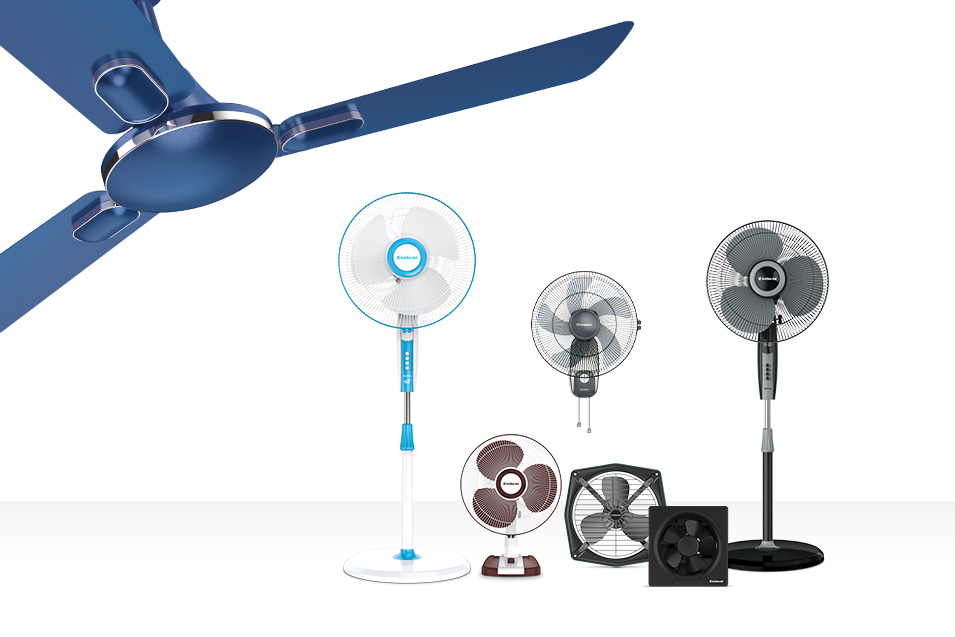
Types of Ceiling Fans: All You Need to Know
03rd July 2025 | Written By: Utsavi Tank | Read Time: 3min | Last Updated: 03rd July 2025
Ceiling fans are a must-have in Indian households, as a convenient and cost-effective cooling appliance. However, with advancements in electrical technology and design, the humble ceiling fan has evolved over the years beyond its basic functionality. From energy efficiency to aesthetics, to smart automation, there are a variety of ceiling fans tailored for everyone’s specific, personal needs. Here’s a complete guide to update you on all the types of ceiling fans available in the market today.
-
Standard Ceiling Fans:
These are the most commonly found fans in homes. They usually come with three or four blades, a down rod for mounting, and basic regulator controls. Available in a range of sizes and colours, standard ceiling fans are a reliable choice for every day cooling.
- Ideal for: Living rooms, bedrooms, and kitchens
- Highlights: Affordable, widely available, functional design
-
BLDC Ceiling Fans (Energy Efficient):
BLDC (Brushless Direct Current) fans use advanced motors that consume significantly less electricity than traditional models. These fans can save up to 65% on power consumption and often come with remote controls for convenience.
- Ideal for: Energy-conscious users, urban homes
- Highlights: Lower electricity bills, silent operation, remote-controlled
-
Designer Ceiling Fans:
If aesthetics is as important to you as performance, designer fans are the perfect match. These fans boast luxurious finishes, unique blade designs, and mood lighting options to elevate your interiors.
- Ideal for: Modern homes, boutique spaces, premium settings
- Highlights: Stylish, available in various colours and themes
-
Under-light Ceiling Fans:
These multi-functional fans combine the utility of air circulation with ambient lighting. Perfect for rooms where you want to reduce the need for separate lighting fixtures, under-light fans are both elegant and practical.
- Ideal for: Bedrooms, dining areas, compact flats
- Highlights: Dual-purpose (fan + light), dimmable lighting options
-
Hugger or Low-Profile Ceiling Fans:
These fans are mounted directly to the ceiling without a down rod, making them suitable for homes with low ceiling heights. They maintain safe clearance while providing efficient airflow.
- Ideal for: Flats with ceilings lower than 8 feet
- Highlights: Compact design, safer for tight spaces
-
Smart Ceiling Fans:
With the rise of smart homes, ceiling fans too have become connected. These fans can be operated via smartphone apps, voice assistants like Alexa or Google Home, and often come with scheduling, speed memory, and sleep mode features.
- Ideal for: Tech-savvy users, smart homes
- Highlights: App and voice control, energy tracking, smart scheduling
-
Outdoor Ceiling Fans:
Specially designed with rust-proof and weather-resistant materials, these fans are ideal for verandas, balconies, and semi-open areas. They provide cooling while withstanding India’s diverse climate.
- Ideal for: Patios, balconies, outdoor kitchens
- Highlights: Durable, water-resistant, robust build
Final Thoughts:
Choosing the right ceiling fan depends on several factors—room size, ceiling height, décor, and energy needs. From traditional models to modern innovations, the ceiling fan has come a long way. Whether you prioritise performance, aesthetics, or sustainability, there’s a fan to suit every space and style.

Frequently Asked Questions (FAQs) :
- Q1. How do I determine the right number of ceiling fans for a large room or hall? Measure the room’s area (length × width). For rooms over 400 sq. ft., consider two fans for balanced airflow. Ideally, use one ceiling fan per 200–300 sq. ft. space. Ensure each fan has adequate clearance from walls (at least 18 inches) and between each other (ideally 10 feet) for efficient air distribution.
- Q2. What’s the best ceiling fan for rooms with sloped or vaulted ceilings? Use a ceiling fan with an angled mounting kit or a sloped ceiling adapter. Opt for a down rod fan, as flush mounts won’t work effectively. Make sure the fan blades have ample clearance and hang at least 7 feet from the floor and 18 inches from sloped surfaces for optimal airflow and safety.
- Q3. Do more blades on a ceiling fan mean better airflow? Not necessarily. More blades can reduce speed and airflow due to added drag. Most efficient fans have 3 to 5 blades. Fewer blades often mean higher airflow and energy efficiency, while more blades offer quieter operation and a more aesthetic look. Choose based on your priority—airflow or design.
- Q4. Can I install a ceiling fan in a room with a false ceiling? Yes, but it requires careful installation. Use a fan box designed for false ceilings, and reinforce it with sturdy anchoring to the true ceiling above. Ensure enough ceiling depth for safe installation and proper airflow. It’s best to consult a professional to ensure safety and secure mounting.




